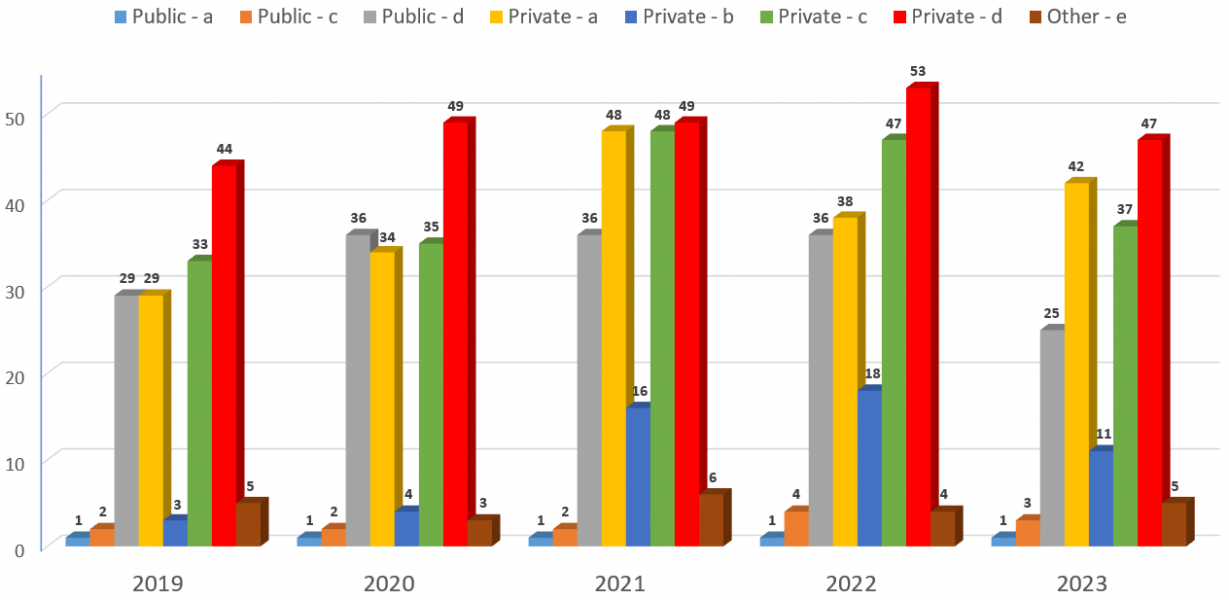References
Alarcon G. M., Lyons J. B., Christensen J. C., Klosterman S. L., Bowers M. A., Ryan T. J., Jessup S. A. and K.T. Wynne, 2017, The Effect of Propensity to Trust and Perceptions of Trustworthiness on trust Behaviors in Dyads, Behavior Research Methods, 50(5), 1906–1920.
Albano G. and A. Lizzeri, 2001, Strategic Certification and the Provision of Quality, International Economic Review, 42(1), 267-283.
Alesina A. and F. Passarelli, 2019, Loss Aversion in Politics, American Journal of Political Science, 63(4), 936-947.
Anagol S., Cole S. and S. Sarkar, 2017, Understanding the Advice of Commissions-Motivated Agents: Evidence from Insurance Market, Review of Economics and Statistics, 99(1), 1-15.
Bachmann R., 2018, Institutions and Trust, in R. Searle, A.-M. Nienaber, and S. B. Sitkin (Eds.), The Routledge Companion to Trust, Routledge, 218–228.
Bank for International Settlements (BIS), 2014, Financial Education Programs and Strategies Approaches and Available Resources, 108104-BRI-FinancialEducationProgramsandStrategies-PUBLIC.pdf.
Bank for International Settlements (BIS), 2021, FinTech and the Digital Transformation of Financial Services: Implications for Market Structure and Public Policies, BIS Working Papers, 117.
Beaver W., Shakespeare C. and M. Soliman, 2006, Differential Properties in the Ratings of Certified vs. Non-Certified Bond Rating Agencies, Journal of Accounting and Economics, 42(3), 303-334.
Benabou R. and G. Laroque, 1992, Using Privileged Information to Manipulate Markets: Insiders, Gurus, and Credibility, Quarterly Journal of Economics, 107(3), 921-958.
Berejikian J., 1997, The Gains Debate: Framing State Choice, American Political Science Review, 91(4), 789-805.
Berry L., 2000, Cultivating Service Brand Equity, Journal of the Academy of Marketing Science, 28(1), 128-137.
Bester H. and M. Dahm, 2018, Credence Goods, Costly Diagnosis and Subjective Evaluation, Economic Journal, 611, 1367-1394.
Berk B.J. and J.H. van Binsbergen, 2022, Regulation of Charlatans in High-Skill Professions, Journal of Finance, 77(2), 1219-1258.
Bian B., Pagel M. and H. Tang, 2023, Consumer Surveillance and Financial Fraud, NBER Working Paper Series, n.31692.
Bitner M.J., 1992, Servicescape: The Impact of Physical Surroundings on Customers and Employees, The Journal of Marketing, 56(2), 57-71.
Bolton P., Freixas X. and J. Shapiro, 2009, The Credit Ratings Game, NBER Working Paper Series, n. 14712.
Bormann I., Niedlich S. and I. Wuerb , 2021, Trust in Educational Settings—What It Is and Why It Matters. European Perspectives, European Education, 53(3/4), 121–136.
Clarke C., 2015, Learning to Fail: Resilience and the Empty Promise of Financial Literacy Education, Consumption, Markets and Culture, 18(3), 257-276.
Colquitt J.A., Scott B.A. and J.A. Lepine, 2007, Trust, Trustworthiness, and Trust Propensity: A Meta-Analytic Test of Their Unique Relationships with Risk Taking and Job Performance, Journal of Applied Psychology, 92(4), 909-927.
Dranove D. and G. Zhe Jin, 2010, Quality Disclosure And Certification: Theory And Practice, NBER Working Paper Series, n.15644.
Druckman J.N. and A. Lupia, 2000, Preference Formation, Annual Review of Political Science, 3, 1-24.
Dulleck U., Gong J. and J. Li, 2013, Contracting for Infrastructure Projects as Credence Goods, Journal of Public Economics Theory, 17 (3), 328–345.
Dulleck U. and R. Kerschbamer, 2006, On Doctors, Mechanics, and Computer Specialists: The Economics of Credence Goods, Journal of Economic Literature, 44(1), 5-42.
Dulleck U. and B.U. Wigger, 2015, Politicians as Experts, Electoral Control, and Fiscal Restraints, Journal of Public Economics, 121, 106–116.
European Banking Authority (EBA), 2020, EBA Report on Financial Education 2019-2020.
European Supervisory Authorities (ESAs), 2023, Joint Committee of the European Supervisory Authorities, Thematic Report on National Financial Education Initiatives on Digitalization.
Farhi E., Lerner J. and J. Tirole, 2008, Fear Rejection? Tiered Certification and Transparency, NBER Working Paper Series, n. 14457.
Favaretto F. and D. Masciandaro, 2016, Doves, Hawks and Pigeons: Behavioural Monetary Policy and Interest Rate Inertia, Journal of Financial Stability, 27, 50-58.
Ferrara F., Masciandaro D., Moschella M. and D. Romelli, 2021, Political Voice on Monetary Policy: Evidence from the Parliamentary Hearings of the European Central Bank, European Journal of Political Economy, 72, 102143, 2021.
Ferrara F., Masciandaro D., Moschella M. and D. Romelli, 2023, What Do Politicians Think of Technocratic Institutions? Experimental Evidence on the European Central Bank, Bocconi Baffi Centre, Working Paper Series, n. 201.
Flegm E., 2005, Accounting at a Crossroad, CPA Journal, 75(12), 16-22.
Frisell L., Roszbach K. and G. Spagnolo, 2008, Governing the Governors: A Clinical Study of Central Banks, CEPR Discussion Papers, n. 6888.
Goedkoop F., Mangan M., Mastrogiacomo M. and S. Hochguertel, 2023, Trust in the Financial Performance of Pension Funds, Public Perception, and its Effects on Participation in Voluntary Pension Saving Plans, De Nederlandsche Bank, Working Paper Series, n.783.
Glazer J., McGuire T., Cao Z. and A. Zaslavsky, 2008, Using Global Ratings of Health Plans to Improve the Quality of Health Care, Journal of Health Economics, 27(5), 1182-1195.
Goyal K. and S. Kumar, 2021, Financial Literacy: A Systematic Review and Bibliometric Analysis, International Journal of Consumer Studies, 45, 80-105.
Griffin J.M., Kruger S. and P. Mahajan, 2023, Did FinTech Lenders Facilitate PPP Fraud?, Journal of Finance, 78(3), 1777-1827.
Grossman S.J., 1981, The Information Role of Warranties and Private Disclosure about Product Quality, Journal of Law and Economics, 24(3), 461-483.
Guiso L., 2010, A Trust-Driven Financial Crisis: Implications for the Future of Financial Markets, EUI Working Paper Series, n. 7.
Hansen T., 2012, Understanding Trust in Financial Services: The Influence of Financial Healthiness, Knowledge, and Satisfaction, Journal of Service Research, 15(3), 280-295.
Hastings J.S., Madrian B.C. and W. L. Skimmyhorn, 2013, Financial Literacy, Financial Education, and Economic Outcomes, Annual Review of Economics, 5, 347-373.
Hvide H. and A. Heifetz, 2001, Free-Entry Equilibrium in a Market for Certifiers, Norwegian School of Economics, Working Paper Series, May, 25.
Jaffer S., Morris N. and D. Vines, 2014, Why Trustworthiness is important, in N. Morris and D. Vines, (Eds.), Capital Failure: Rebuilding Trust in Financial Services, Oxford University Press, Oxford.
Kahneman D. and A. Tversky, 1988, Rational Choice and the Framing of Decisions, in D.E. Bell, H. Raiffa and A. Tversky, (Eds.), Decision Making: Descriptive, Normative, and Prescriptive Interactions, Cambridge University Press, Cambridge, 167-192.
Inderst R. and M. Ottaviani, 2012, Competition Through Commissions and Kickbacks, American Economic Review, 102 (2), 780–809.
Lepsius, M. R., 2017, Trust in Institutions. In M. R. Lepsius and C. Wendt (Eds.), Max Weber and Institutional Theory, 79–87, Springer.
Lin H., Gursoy D. and M. Zhang, 2020, Impact of Customer-to-Customer Interactions on Overall Service Experience: A Social Servicescape Perspective, International Journal of Hospitality Management, 87, 102376.
Lizzeri A., 1999, Information Revelation and Certification Intermediaries, RAND Journal of Economics, 30(2), 214-231.
Loewenstein G. and Z. Wojtowicz, 2023, The Economics of Attention, CESIFO Working Papers, n. 10712.
Lumineau F. and O. Schilke, 2018, Trust Development across Levels of Analysis: An Embedded-Agency Perspective, Journal of Trust Research, 8(2), 238–248.
Lusardi A. and O.S. Mitchell, 2023, The Importance of Financial Literacy: Opening a New Field, Journal of Economic Perspectives, 37(4), 137-154.
Manea N. and M. Purcaru, 2017, Mapping Educational Marketing, Procedia of Economics and Business Administration, https://doi.org/10.26458/v4.i1.30.
Masciandaro D., 2023, Politicians, Trust, Financial Literacy and Financial Education: When Do They Care?, Bocconi University, Baffi Centre Working Paper Series, n.208.
Mathis J., Mc Andrews J. and J. Rochet, 2009, Rating the Raters: Are Reputation Concerns Powerful Enough to Discipline Rating Agencies?, Journal of Monetary Economics, 56(5), 657-674.
Mercer J., 2005, Prospect Theory and Political Science, Annual Review of Political Science, 8, 1-21.
Miao C., 2009, Competition in Quality Standards, Journal of Industrial Economics, 57, 1-21.
Miller N., Resnick P. and R. Zechhauser, 2005, Eliciting Information Feedback: The Peer- Prediction Method, Management Science, 51(9),1359-1373.
Nikolova N., Möllering G. and M. Reihlen, 2015, Trusting as a ‘Leap of Faith’: Trust-Building Practices in Client–Consultant Relationships, Scandinavian Journal of Management, 31(2), 232–245.
OECD, 2022, Guidance on Digital Delivery of Financial Education.
OECD, 2018, Policy Guidance on Digitalization and Financial Literacy.
Pigou, A., 1938, The Economics of Welfare, Macmillan & Co., London.
Quattrone G. and A. Tversky, 1988, Contrasting Rational and Psychological Analyses of Political Choices, American Political Science Review, 82, 719-736.
Rao H., 1994, The Social Construction of Reputation: Certification Contests, Legitimation, and the Survival of Organizations in the American Automobile Industry: 1895-1912, Strategic Management Journal, 29-44.
Ronson J., Farkuhar J.D., 2014, A Brave New World: Branding in Financial Services, in T. Harrison and H. Estelami, (Eds.), Routledge Companion To Financial Services Marketing, Routledge, London.
Romelli D. , 2022, The Political Economy of Reforms in Central Bank Design: Evidence from a New Dataset, Economic Policy, 37(112), 641-688.
Sanders G. and S. Boivie, 2004, Sorting Things Out: Valuation of New Firms in Uncertain Markets, Strategic Management Journal, 25, 167-186.
Sapienza P. and L. Zingales, 2012, A Trust Crisis, International Review of Finance, 12(2), 123-131.
Scharfstein D. and J. Stein, 1990, Herding Behaviour and Investment, American Economic Review, 80(3), 465-479.
Scheffer L., Loewen P.J., Soroka S., Walgrave S. and T. Sheafer, 2018, Nonrepresentative Representatives: An Experimental Study of the Decision Making of Elected Politicians, American Political Science Review, 112(2), 302-321.
Shleifer A. and R. Vishny, 1998, The Grabbing Hand, Harvard University Press, Cambridge Massachusetts.
Sirdeshmukh D., Singh J. and B. Sabol, 2002, Consumer Trust, Value, and Loyalty in Relational Exchanges, Journal of Marketing, 66(1), 15-37.
Soroka S., 2014, Negativity in Democratic Politics: Causes and Consequences, Cambridge University Press, Cambridge UK.
Stensaker, B. and D’Andrea, V., 2007, Branding – The Why, What and How Phenomenon, in B. Stensaker and V. D’Andrea V. (Eds.), Branding in Higher Education. Exploring an Emerging Phenomenon, EAIR Series Research, Policy and Practice in Higher Education, The European, Amsterdam, 6-13.
Stolper O.A. and A. Walter, 2017, Financial Literacy, Financial Advice, and Financial Behavior, Journal of Business Economics, 87, 581-643.
Van der Cruijsen C., de Haan J. and R. Roerink, 2021, Trust in Financial Institutions: A Survey, Journal of Economic Surveys, 10.1111
Van Esterik – Plasmeijer P.W.J. and W.F. van Raaij, 2017, Banking System Trust, Bank Trust, and Bank Loyalty, International Journal of Bank Marketing, 35(1), 97-111.
Van Ryzin G. G., 2011, Outcomes, Process, and Trust of Civil Servants, Journal of Public Administration Research and Theory, (21), 745–760.
Vigoda-Gadot and F. Yuval, 2003, Managerial Quality, Administrative Performance and Trust in Governance Revisited: A Follow‐up Study of Causality, International Journal of Public Sector Management, 16(7), 502-522.
Wade J.B., Porac J.F., Pollock T.G. and S.D. Graffin, 2006, The Burden of Celebrity: The Impact of Ceo Certification Contests on Ceo Pay and Performance, Academy of Management Journal, 46(4), 643-660.
Willis L.E., 2011, The Financial Education Fallacy, American Economic Review, 101(3), 429-434.
World Bank, 2014, Financial education programs and strategies: approaches and available resources, Washington D.C.
World Bank, 2021, Building a Financial Education Approach A Starting Point for Financial Sector Authorities, Financial Inclusion Support Framework.
Zeithaml C.P and V.A. Zeithaml, 1984, Environmental Management: Revising the Marketing Perspective, Journal of Marketing, 48(2), 46-53.
Zucker L.G.,1986, Production of Trust: Institutional Sources of Economic Structure, Research in Organizational Behavior, 8, 53–111.





